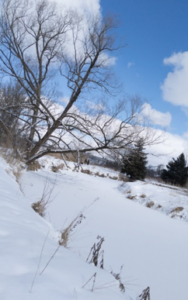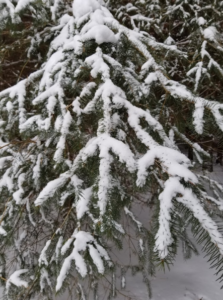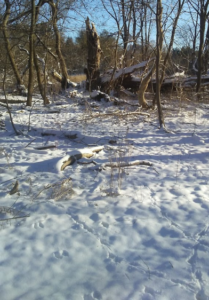Date: January 15, 2024
Time: 1100–1200 hours
Location: Bailey Ecological Park, Newmarket, Ontario, Canada
Coordinates: 44.0342592212851° N, -79.46255827331866° W
Study Area Description: Bailey Ecological Park is located at 360 Mulock Drive in Newmarket, Ontario, Canada. It is about 25 acres in size and is distinguished by its diverse natural features. The park’s topography consists of wetlands, meadows, and forested areas, which provide habitat for a variety of species of plants and animals. The park is designated as an ecological park, emphasizing its importance in preserving and promoting the local ecosystem. The ground is covered in snow, making the landscape look like a winter wonderland. The park is a designated municipal conservation area that serves as a haven for local wildlife.
Observations:
Wildlife: Despite winter conditions, tracks in the snow indicate the passage of small mammals and birds. The frozen East Holland River provided potential habitat for aquatic species.
Human Activity: There was little human activity observed during the visit, with only a few people engaging in winter activities such as walking. The park’s trail system seemed well-kept. The park is a city recreational area that provides a natural space for residents to enjoy outdoor activities, even in the winter months.
Weather Conditions: The temperature was around -5°C (23°F), with light snowfall and overcast skies. The presence of snow indicates recent snowfall or consistent low temperatures that maintain the snow cover.
Research Project Questions:
1. How does winter impact the behaviour and survival strategies of local wildlife in Bailey Ecological Park?
2. How does snow cover affect the park’s plant biodiversity? How do different species adapt?
3. How do temperature fluctuations during Ontario winters affect ecological processes in Bailey Ecological Park?
Field Journal Images:
Image 1: Overview

The picture shows a clear sky with scattered clouds over a winter landscape of snow-covered ground and leafless deciduous trees. The ground looks like it has both flat areas and gentle slopes. The area’s mixed vegetation is indicated by the distant sight of a few evergreen trees. The snow cover implies that the ground is not visible, which could obscure some of the smaller plant species and ground features.
Image 2: Conifer Tree

This image displays a close-up of a snow-covered evergreen conifer tree’s branches. This picture offers a closer look at the kinds of plants that grow in Bailey Ecological Park in the winter. The snow that has accumulated on the branches indicates a recent snowfall and temperatures that are low enough to keep the snow from melting. In temperate climates, this kind of vegetation is typical of the winter landscape and serves as crucial habitat and cover for wildlife during the cold months.
Image 3: Wooden Area

The picture depicts a densely wooded area in winter, with thin, bare trees that allow sunlight to filter through and cast shadows on the snow-covered ground. There is evidence of broken trees and branches, indicating that this ecosystem is subject to natural processes like windthrow and decay. Although there are occasional spots where there seem to be animal tracks, the snow cover is generally uniform and suggests some wildlife activity. The scene is typical of a temperate winter woodland, with the forest floor more exposed to sunlight than it would be during the summer due to the deciduous trees’ loss of leaves. This change in canopy cover could have an impact on the understorey and forest floor, potentially affecting microclimate and habitat conditions for various species.